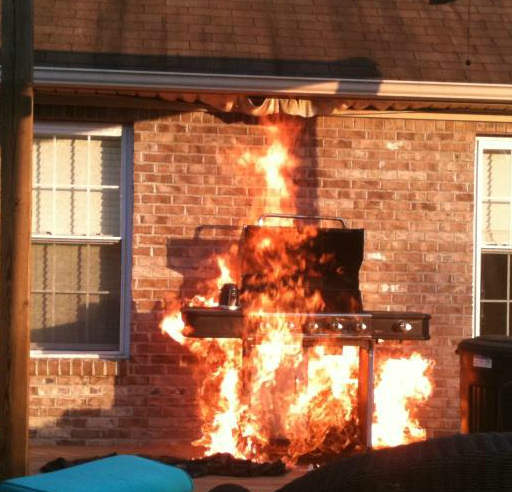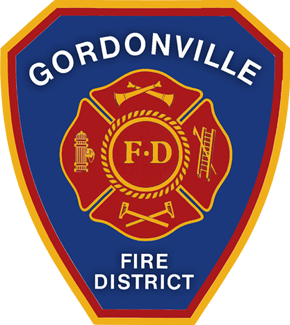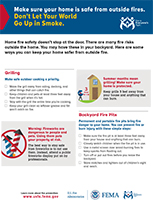Barbecue Fire Safety

BBQ Cleaning & Maintenance:
- Clean burner ports with pipe cleaner, wire, or specialty wire brushes to remove any rust, dirt, spider webs and food particles.
- Check hoses for cracks or damage and replace, if necessary.
- Check hose connections for leaks by brushing a 50% liquid dish soap and 50% water solution onto all hose connections and valves. Bubbles indicate a leak. If you encounter a leak, shut off the propane at the tank, tighten all hose connections and check again for leaks. NEVER use matches or lighters to check for leaks.
- Keep your barbecue clean of grease or food build-up that can start a fire. Empty the grease trap regularly.
- Use a bucket of warm sudsy water to wash grease and food build-up off of lava rocks or bricks.
- Inspect the propane cylinder for cuts, gouges, dents and rusting. Replace the propane cylinder, if necessary.
BBQ Safe Placement:
- Always position your barbecue on a flat, sturdy, non-combustible surface such as concrete or patio stones.
- To eliminate the chance of a fire spreading beyond the barbecue, position your barbecue 10 feet away from your home, fences, garage, trees, overhangs, open windows and doors.
- Always barbecue OUTSIDE in a WELL-VENTILATED area away from any open windows or doors. Barbecuing produces fumes and gases, such as carbon monoxide, which can be harmful and deadly.
- Never use a barbecue in any enclosed or partially enclosed area such as a garage or porch.
- Check with your condominium or apartment management on their regulations governing the use of barbecues. If allowed, special restrictions may apply.
BBQ Safe Operation:
- Ensure the barbecue is in the care of a responsible adult at all times.
- Establish a 3 foot safety zone around the barbecue – NO KIDS AND NO PETS ALLOWED.
- Never leave a lit barbecue unattended.
- Never leave unsupervised children near a barbecue.
- Don’t wear loose clothing that may come into contact with the grill and catch fire. Use long-handled barbecue tools and flame resistant oven mitts.
- Secure or remove your barbecue lighter. Keep them out of kids’ reach.
- Follow the manufacturers’ instructions when lighting your barbecue. Always open the barbecue lid before lighting. Have your barbecue lighter or match ready. Turn on the propane cylinder by turning on the valve. Now turn on the barbecue at the burner controls. Light the barbecue using the igniter button or by inserting a long match or barbecue lighter into the side burner hole. If the burner fails to ignite, keep the lid open, turn off the gas at the cylinder and wait 5 minutes to allow any build-up of vapors to clear before trying again.
- When you are done barbecuing, first shut off the valve on the propane cylinder. This will allow any gas remaining in the hose line to be burned off. Once the cylinder is shut off and all gas in the hose line has been burned off, turn off the burner controls on the barbecue. Allow the barbecue to cool down fully before placing any protective cover on it.
- Remember, barbecues can potentially be dangerous when mixed with carelessness or excessive alcohol. Use alcohol responsibly around barbecues.
- Have a fire extinguisher or garden hose connected to a water supply nearby in case of a fire.
Propane Cylinder Safety:
- Propane is heavier than air and will flow to low lying areas. Propane has a chemical added to it to give it a distinctive odor like rotten eggs or boiling cabbage. If you suspect a leak or smell an odor, shut off the propane cylinder – DO NOT TRY TO LIGHT THE GRILL.
- Propane cylinders must be inspected and re-certified or replaced every 10 years. The date of manufacture or the last valid inspection mark is stamped on the collar of the cylinder.
- Prior to 1994, propane cylinder valves had a left hand thread (counter-clockwise). Since 1994, propane cylinders have been designed with a right hand thread (clockwise) or a quick disconnect device.
- Inspect the propane cylinder for cuts, gouges, dents and rusting and replace, if necessary.
- Check hose connections for leaks by brushing a 50% liquid dish soap and 50% water solution onto all hose connections and valves. Bubbles indicate a leak. If you encounter a leak, shut off the propane at the tank, tighten all hose connections and check again for leaks. NEVER use matches or lighters to check for leaks.
- Always transport and store propane cylinders in an upright, vertical position in order that the safety release valve will function properly.
- Never store propane tanks indoors or near any heat source.
- When transporting a propane cylinder in a vehicle ensure the cylinder valve is tightly closed, install the threaded plug or cap on the valve outlet of the tank, secure the tank in an upright, vertical position in the passenger compartment of your vehicle, open all vehicle windows for ventilation and REFRAIN FROM SMOKING during transportation. If transporting a propane cylinder in the trunk of a vehicle, ensure that it’s well secured in an upright, vertical position and the trunk lid is left open for ventilation until your return home.
- Remove the tank from the vehicle IMMEDIATELY upon your return home – heat build-up in a sealed vehicle may cause an explosion.
- Remember, empty propane cylinders are equally as dangerous as full cylinders and the same safety precautions must be followed. NEVER attempt to disassemble or cut open a propane cylinder, which could result in an explosion and flash fire. Dispose of your old propane tank safely by dropping it off, free of charge, at the Chemical Waste Depot at Central Ave. and North Service Rd. E. (call 311 for further information).
- If you discover a propane leak – clear all people from the area – remove any heat sources – call 911.
- If your propane cylinder is involved in a fire – clear all people from the area – call 911.
- Propane cylinders are painted a light or reflective color to reduce heat absorption from the sun, which increases the internal pressure within tank. Never paint a propane cylinder a dark color.
Charcoal Barbecues:
- The same rules of safe barbecuing apply to charcoal barbecues.
- Follow the manufacturer’s instructions. Use only sufficient charcoal to cover the base of the barbecue to a depth of about 2 inches.
- Store extra charcoal in a metal container with a tight-fitting lid to keep it dry. Wet charcoal can spontaneously combust and start a fire.
- Never use gasoline as an aid to ignite charcoal briquettes, only use proper charcoal lighting fluid. Use the lighting fluid sparingly and NEVER PUT IT ON AN OPEN FLAME since the fire can ignite the stream of lighting fluid, igniting the container in your hand. Once the lighting fluid has been applied to the charcoal, allow a few minutes for the explosive vapors to disperse before lighting.
- Remember, burning charcoal produces carbon monoxide gas – always barbecue OUTSIDE in a WELL-VENTILATED area away from any open windows or doors.
- Never use a barbecue in any enclosed or partially enclosed area such as a garage or porch.
- Ensure the coals are completely out before disposing of them – wearing oven mitts, use long-handled tongs to remove the coals and immerse them in a metal container filled with water.
Follow Us on Facebook!
Contact Information
Mailing Address:
P.O. BOX 97
Gordonville, MO 63752 US(P) 573.204.9100
(F) 573.204.9102Powered by:
Maximum Impact Development

